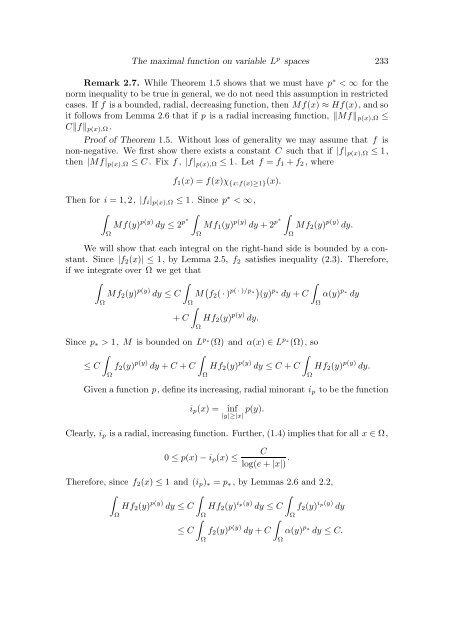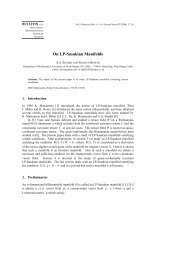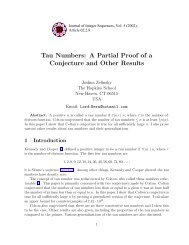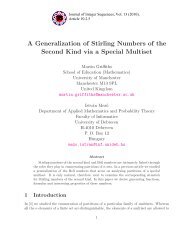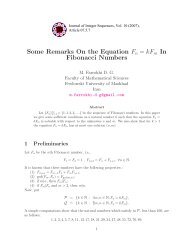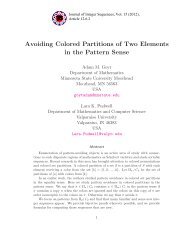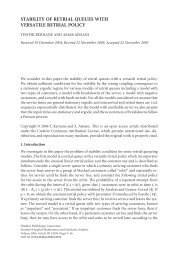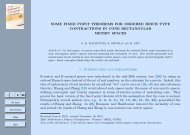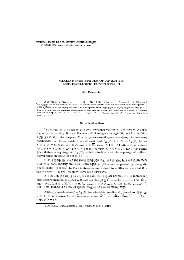THE MAXIMAL FUNCTION ON VARIABLE Lp SPACES
THE MAXIMAL FUNCTION ON VARIABLE Lp SPACES
THE MAXIMAL FUNCTION ON VARIABLE Lp SPACES
You also want an ePaper? Increase the reach of your titles
YUMPU automatically turns print PDFs into web optimized ePapers that Google loves.
The maximal function on variable L p spaces 233Remark 2.7. While Theorem 1.5 shows that we must have p ∗ < ∞ for thenorm inequality to be true in general, we do not need this assumption in restrictedcases. If f is a bounded, radial, decreasing function, then Mf(x) ≈ Hf(x), and soit follows from Lemma 2.6 that if p is a radial increasing function, ‖Mf‖ p(x),Ω ≤C‖f‖ p(x),Ω .Proof of Theorem 1.5. Without loss of generality we may assume that f isnon-negative. We first show there exists a constant C such that if |f| p(x),Ω ≤ 1,then |Mf| p(x),Ω ≤ C . Fix f , |f| p(x),Ω ≤ 1. Let f = f 1 + f 2 , wheref 1 (x) = f(x)χ {x:f(x)≥1} (x).Then for i = 1, 2, |f i | p(x),Ω ≤ 1. Since p ∗ < ∞,∫∫∫Mf(y) p(y) dy ≤ 2 p∗ Mf 1 (y) p(y) dy + 2 p∗ΩΩΩMf 2 (y) p(y) dy.We will show that each integral on the right-hand side is bounded by a constant.Since |f 2 (x)| ≤ 1, by Lemma 2.5, f 2 satisfies inequality (2.3). Therefore,if we integrate over Ω we get that∫∫Mf 2 (y) p(y) dy ≤ C M ( f 2 ( · ) p( · )/p ) ∫∗(y) p ∗dy + C α(y) p ∗dyΩΩΩ∫+ C Hf 2 (y) p(y) dy.ΩSince p ∗ > 1, M is bounded on L p ∗(Ω) and α(x) ∈ L p ∗(Ω), so∫∫∫≤ C f 2 (y) p(y) dy + C + C Hf 2 (y) p(y) dy ≤ C + C Hf 2 (y) p(y) dy.ΩΩGiven a function p, define its increasing, radial minorant i p to be the functioni p (x) =inf p(y).|y|≥|x|Clearly, i p is a radial, increasing function. Further, (1.4) implies that for all x ∈ Ω,0 ≤ p(x) − i p (x) ≤Clog(e + |x|) .Therefore, since f 2 (x) ≤ 1 and (i p ) ∗ = p ∗ , by Lemmas 2.6 and 2.2,∫∫∫Hf 2 (y) p(y) dy ≤ C Hf 2 (y) ip(y) dy ≤ C f 2 (y) ip(y) dyΩΩΩ∫∫≤ C f 2 (y) p(y) dy + C α(y) p ∗dy ≤ C.ΩΩΩ


